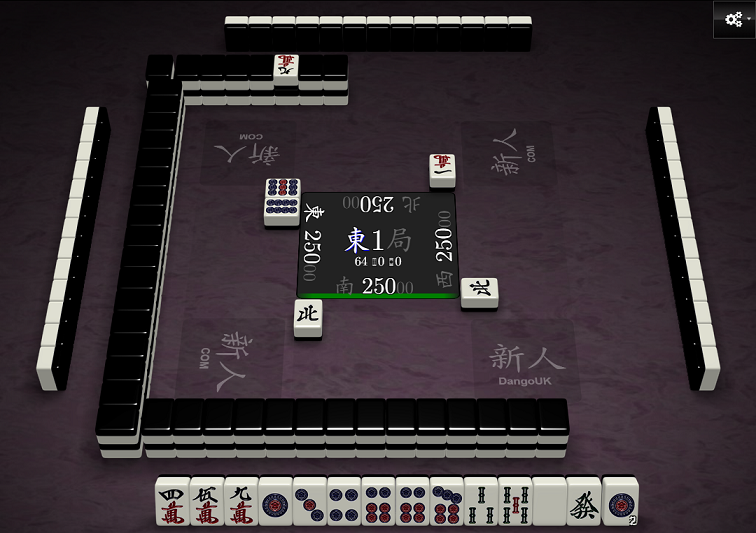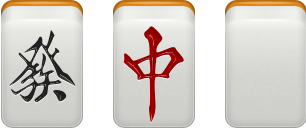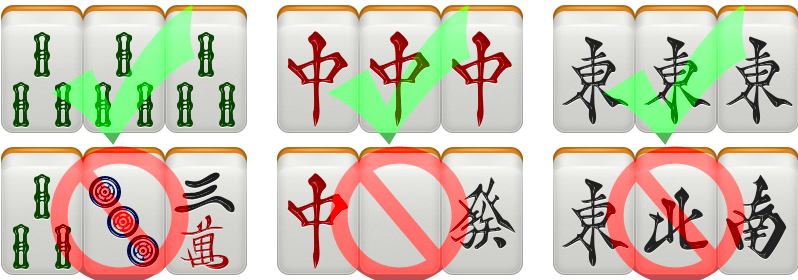Overview of Riichi Mahjong (リーチ麻雀)
Riichi Mahjong, also known as Reach Mahjong, is a Japanese variant of four-player mahjong. The following rules follow the standards established by the European Mahjong Association (EMA).

Basic Gameplay Structure

Objective
Players aim to complete a valid hand, known as Agari (和了), consisting of 4 groups and 1 pair.
A valid hand must contain at least one Yaku (役).
Tiles
Similar to a traditional deck of cards, the tiles in Riichi Mahjong can be divided into categories to better understand what you're working with. For now, we'll consider these five categories:
Pins, Man and Sou
These tiles are most similar to cards in a traditional deck. Each of these three suits have numbered tiles from 1 to 9. Players further divide these into "Terminals" (1 & 9) and "Simples" (2-8). This is done for scoring purposes which we'll discuss later on.



Image © Paweł Marczewski - Hand Generator. Tile graphics taken from martinpersson.org.
Winds
Alongside the suits of Pins, Man and Sou, there are four Wind tiles:
Generally, the symbols for the four winds look similar to the first letter of their English counterparts. The middle of the East looks like an E, the curves of the South look like an S, the bottom of the West looks like a W and the shape of the North looks like an N.
Dragons
Finally, there are three types of Dragon tiles:

Notes
Groups
In Riichi Mahjong, groups of three can consist of a Triplet or a Sequence.
Triplets must be identical in value and suit. For example, a triplet of threes must be a triplet of three-bamboos, three-pins or three-man. Winds and Dragons can be used as Triplets under the same rules. A triplet of East Winds is valid and a triplet of Red Dragons is valid. Mixing different winds and dragons in one triplet is not valid.

Sequences of three must all be in the same suit. The below shows examples of a 3-4-5 sequence. The left-most is a valid sequence as all tiles are in the Sou/Bamboo suit. The other two mix suits from the Man and Pin suits which means that are invalid. The numbers do not wrap around either, so a 7-8-9 sequence is valid but 8-9-1 is not.

You spend the majority of the game drawing and discarding tiles to build up these groups of three. Keeping duplicate tiles can help to build triplets and ensure you have a pair. Keeping similarly numbered tiles within the same suit can help to build sequences.
Winning a Hand (Agari / 和了)

Image © Paweł Marczewski - Hand Generator. Tile graphics taken from martinpersson.org.
Tenpai (聴牌) & Furiten (振聴)
When you are only one tile away from winning, you are considered to be "in tenpai (聴牌)".
However, a player in tenpai who has already discarded one of their winning tiles is considered to be "in furiten (振聴)".
This means that they are unable to win using someone else's discards (Ron) but can still win by drawing the tile themselves (Tsumo).
Scoring (Tensu Keisan / 点数計算)
Scoring is based on Han (翻) and Fu (符), which determine how many points are awarded. The simplest hands can be worth as little as 1000 points whereas complex hands like Yakuman (役満) are the most valuable earning 32000+ points. Scoring is discussed in more detail here.